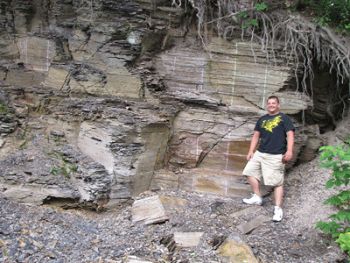Juniata College PA
Marcellus shale is well known as a natural gas play in the northeastern United States of America. A fracture density and geochemical study was conducted on Marcellus outcrops in central Pennsylvania to better understand physical and chemical weathering processes and relationships within the weathering profile of the Marcellus. The fracture density study served to provide quantitative data on the abundance of fractures in exposed Marcellus shale. As hypothesized, progressively higher fracture density values (FDV) were calculated closer to the soil profile. Understanding fracture densities and their associated depths can be used to explain why soil formation rates are faster. A study of this kind also has applications to natural gas extraction. The geochemical study was conducted to observe elemental depletion and movement within the soil profile. Lysimeters were installed to collect soil water in which major, trace elements, and Cu isotope compositions were measured. These concentrations and isotope ratios are important to understanding the extent of biogeochemical reactions.
10 °C Temp
1070 mm Precip
Parent Field Area:
Shale Transect ▲
Justin Paul (undergraduate - Juniata) beside one of the outcrops investigated for fracture density.
-
Setting & Research
Marcellus shale is well known as a natural gas play in the northeastern United States of America. A fracture density and geochemical study was conducted on Marcellus outcrops in central Pennsylvania to better understand physical and chemical weathering processes and relationships within the weathering profile of the Marcellus.
The fracture density study served to provide quantitative data on the abundance of fractures in exposed Marcellus shale. As hypothesized, progressively higher fracture density values (FDV) were calculated closer to the soil profile. Understanding fracture densities and their associated depths can be used to explain why soil formation rates are faster. A study of this kind also has applications to natural gas extraction. The geochemical study was conducted to observe elemental depletion and movement within the soil profile. Lysimeters were installed to collect soil water in which major, trace elements, and Cu isotope compositions were measured. These concentrations and isotope ratios are important to understanding the extent of biogeochemical reactions. The site is located at 40.66552 latitude and -77.90495 longitude.
-
Dynamic Map
To fully zoom into a small area, you may need to visit the "Map" button and uncheck "Terrain" view.
-
Data
No datasets for this field area have been entered yet
-
Partner Organizations
-
Geology
"Marcellus shale is well known as a natural gas play in the northeastern United States of America. A fracture density and geochemical study was conducted on Marcellus outcrops in central Pennsylvania to better understand physical and chemical weathering processes and relationships within the weathering profile of the Marcellus.
The fracture density study served to provide quantitative data on the abundance of fractures in exposed Marcellus shale. As hypothesized, progressively higher fracture density values (FDV) were calculated closer to the soil profile. Understanding fracture densities and their associated depths can be used to explain why soil formation rates are faster. A study of this kind also has applications to natural gas extraction. The geochemical study was conducted to observe elemental depletion and movement within the soil profile. Lysimeters were installed to collect soil water in which major, trace elements, and Cu isotope compositions were measured. These concentrations and isotope ratios are important to understanding the extent of biogeochemical reactions."
Explore Further


